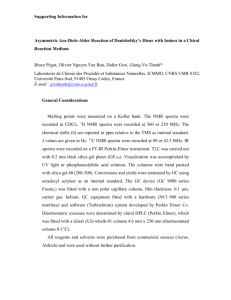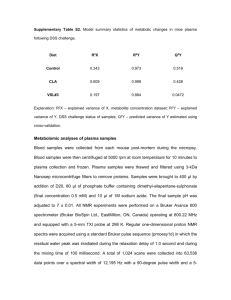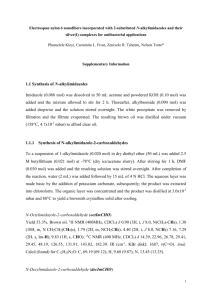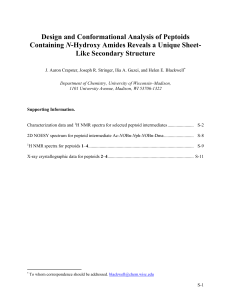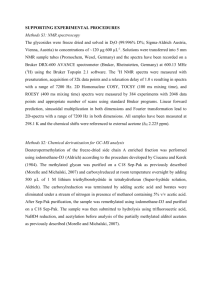poc_1917_sm
advertisement
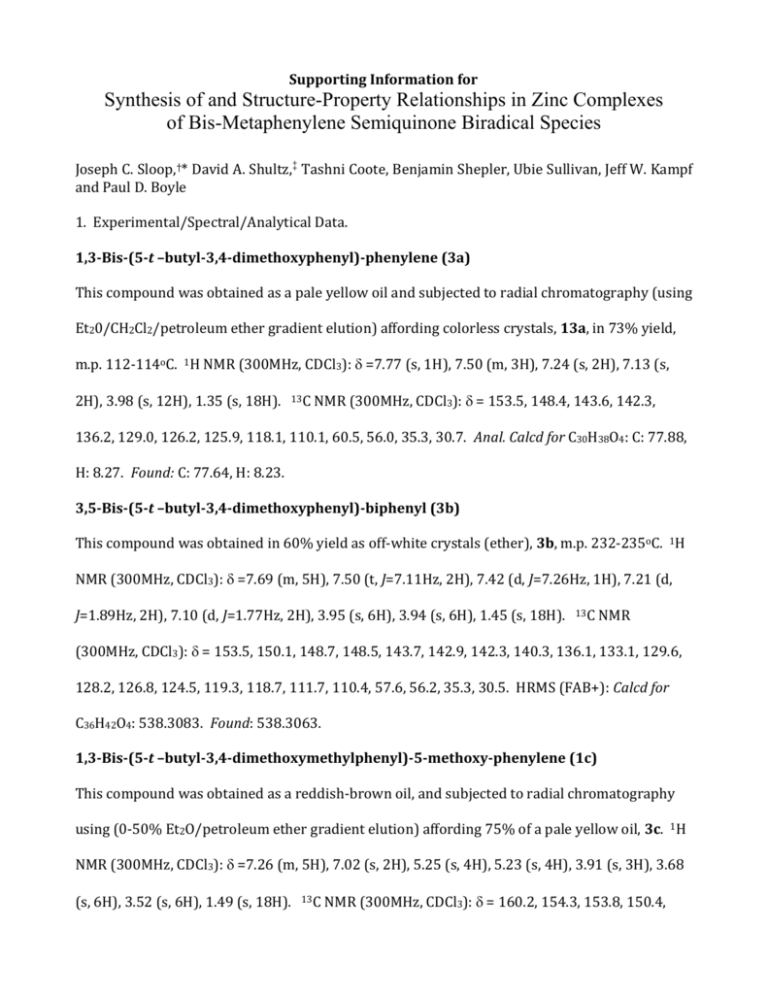
Supporting Information for Synthesis of and Structure-Property Relationships in Zinc Complexes of Bis-Metaphenylene Semiquinone Biradical Species Joseph C. Sloop,†* David A. Shultz,‡ Tashni Coote, Benjamin Shepler, Ubie Sullivan, Jeff W. Kampf and Paul D. Boyle 1. Experimental/Spectral/Analytical Data. 1,3-Bis-(5-t –butyl-3,4-dimethoxyphenyl)-phenylene (3a) This compound was obtained as a pale yellow oil and subjected to radial chromatography (using Et20/CH2Cl2/petroleum ether gradient elution) affording colorless crystals, 13a, in 73% yield, m.p. 112-114oC. 1H NMR (300MHz, CDCl3): =7.77 (s, 1H), 7.50 (m, 3H), 7.24 (s, 2H), 7.13 (s, 2H), 3.98 (s, 12H), 1.35 (s, 18H). 13C NMR (300MHz, CDCl3): = 153.5, 148.4, 143.6, 142.3, 136.2, 129.0, 126.2, 125.9, 118.1, 110.1, 60.5, 56.0, 35.3, 30.7. Anal. Calcd for C30H38O4: C: 77.88, H: 8.27. Found: C: 77.64, H: 8.23. 3,5-Bis-(5-t –butyl-3,4-dimethoxyphenyl)-biphenyl (3b) This compound was obtained in 60% yield as off-white crystals (ether), 3b, m.p. 232-235oC. 1H NMR (300MHz, CDCl3): =7.69 (m, 5H), 7.50 (t, J=7.11Hz, 2H), 7.42 (d, J=7.26Hz, 1H), 7.21 (d, J=1.89Hz, 2H), 7.10 (d, J=1.77Hz, 2H), 3.95 (s, 6H), 3.94 (s, 6H), 1.45 (s, 18H). 13C NMR (300MHz, CDCl3): = 153.5, 150.1, 148.7, 148.5, 143.7, 142.9, 142.3, 140.3, 136.1, 133.1, 129.6, 128.2, 126.8, 124.5, 119.3, 118.7, 111.7, 110.4, 57.6, 56.2, 35.3, 30.5. HRMS (FAB+): Calcd for C36H42O4: 538.3083. Found: 538.3063. 1,3-Bis-(5-t –butyl-3,4-dimethoxymethylphenyl)-5-methoxy-phenylene (1c) This compound was obtained as a reddish-brown oil, and subjected to radial chromatography using (0-50% Et2O/petroleum ether gradient elution) affording 75% of a pale yellow oil, 3c. 1H NMR (300MHz, CDCl3): =7.26 (m, 5H), 7.02 (s, 2H), 5.25 (s, 4H), 5.23 (s, 4H), 3.91 (s, 3H), 3.68 (s, 6H), 3.52 (s, 6H), 1.49 (s, 18H). 13C NMR (300MHz, CDCl3): = 160.2, 154.3, 153.8, 150.4, 145.8, 143.7, 143.2, 136.2, 124.9, 120.2, 119.5, 114.5, 111.7, 99.0, 98.3, 95.5, 94.8, 70.4, 57.2, 56.0, 35.4, 31.4. HRMS (FAB+): Calcd for C35H48O9: 612.3298. Found: 612.3329. 1,3-Bis-(5-t –butyl-3,4-dihydroxyphenyl)-phenylene (4a) Using method B, this compound was obtained in 91% yield as tan crystals, 4a, m.p. 164-167oC. 1H NMR (300MHz, CDCl3): =7.62 (s, 1H), 7.42 (s, 3H), 7.13 (s, 2H), 7.01 (s, 2H), 5.75 (s,2H), 5.53 (s, 2H), 1.47 (s,18H). 13C NMR (300MHz, CDCl3): = 143.2, 143.1, 141.9, 136.7, 132.7, 129.0, 125.5, 125.3, 118.4, 112.0, 34.8, 29.6. IR (cm-1): 3480. Anal. Calcd for C26H30O4: C: 76.81, H: 7.76, Found: C: 76.49, H: 7.70. 3,5-Bis-(5-t –butyl-3,4-dihydroxyphenyl)-biphenyl (4b) Using method B, this compound was obtained in 93% yield as tan crystals, 4b, m.p. 100-103oC. 1H NMR (300MHz, CDCl3): =7.66 (d, J=7.5 Hz, 2H), 7.62 (s, 2H), 7.61 (d, J=8.1 Hz, 2H), 7.47 (t, J=6.9 Hz, 3H), 7.42 (d, J=6.6 Hz, 1H), 7.26 (d, J=3.6 Hz, 2H), 7.16 (s, 2H), 7.04 (s, 2H), 1.47 (s,18H). 13C NMR (300MHz, CDCl3): = 143.6, 142.7, 136.5, 132.7, 129.0, 127.6, 124.5, 123.2, 121.5, 118.5, 112.3, 35.1, 29.8. IR (cm-1): 3391. HRMS (FAB+): Calcd for C32H34O4: 482.2457. Found: 482.2453. 1,3-Bis-(5-t –butyl-3,4-dihydroxyphenyl)-5-methoxyphenylene (4c) Using method A, this compound was obtained in 95% yield as red crystals, 4c, m.p. 122-124oC. 1H NMR (300MHz, CDCl3): = 7.10 (s, 1H), 7.11 (s, J=2.9Hz, 2H), 6.97 (d, J=2.0Hz, 4H), 3.90 (s, 3H), 3.51 (s, 4H), 1.45 (s,18H). 13C NMR (300MHz, CDCl3): = 159.2, 146.7, 143.5, 143.3, 136.9, 132.7, 118.6, 112.2, 111.2, 55.7, 35.1, 29.8. IR (cm-1): 3508. HRMS (FAB+): Calcd for C27H32O5: 436.2250. Found: 436.2241. Complex 5a-H This compound was obtained in 83% yield as green crystals (hexanes), 5a. IR (cm-1): 2953, 2536, 1520, 1440, 1365, 1178. UV-Vis (cm-1): 23000, 13623. Complex 5b-m-Ph This compound was obtained in 83% yield as green crystals (hexanes), 5b. IR (cm-1): 2953, 2547, 1521, 1440, 1365. UV-Vis (cm-1): 21500, 12619. Complex 5c-m-OCH3 This compound was obtained in 77% yield as green crystals (hexanes), 5c. IR (cm-1): 2953, 2547, 1515, 1439, 1178. UV-Vis (cm-1): 21200, 14600. 2. Bis(ZnII(SQ)TpCum,Me) Complex Absorption Spectra 2.5 2 1.5 m -CH O 3 Abs 1 m-Phenyl 0.5 H 0 2.4 10 4 2.2 10 4 2 10 4 4 4 1.8 10 1.6 10 1.4 10 -1 Wavenumber (c m ) 4 1.2 10 4 1 10 4 8000 Figure S1. UV-Vis spectra of the Bis(ZnII(SQ)TpCum,Me) Complexes. 3. Bis(ZnII(SQ)TpCum,Me) Complex X-Ray Data Experimental for C104H117B2N12O4Zn2•C6H14 (5a) Structure Determination. Plate-like green crystals of 5a were grown from hexanes at 25 deg. C. A crystal of dimensions 0.34 x 0.24 x 0.12 mm was mounted on a standard Bruker SMART 1K CCD-based X-ray diffractometer equipped with a LT-2 low temperature device and normal focus Mo-target X-ray tube ( = 0.71073 A) operated at 2000 W power (50 kV, 40 mA). The X-ray intensities were measured at 123(2) K; the detector was placed at a distance 4.969 cm from the crystal. A total of 3000 frames were collected with a scan width of 0.5 in and phi with an exposure time of 60 s/frame. The integration of the data yielded a total of 127468 reflections to a maximum 2 value of 44.22 of which 13121 were independent and 10557 were greater than 2 (I). The final cell constants (Table 1) were based on the xyz centroids of 9221 reflections above 10 (I). Analysis of the data showed negligible decay during data collection; the data were processed with SADABS and corrected for absorption. The structure was solved and refined with the Bruker SHELXTL (version 6.12) software package, using the space group P2(1)/c with Z = 4 for the formula C104H117B2N12O4Zn2•C6H14. All non-hydrogen atoms were refined anisotropically with the hydrogen atoms placed in idealized positions. The equivalent of 4 hexane lattice solvates per unit cell, disordered about inversion cenetrs in the crystal lattice were modeled by use of the SQUEEZE subroutine of the PLATON program suite. Full matrix least-squares refinement based on F2 converged at R1 = 0.0858 and wR2 = 0.1777 [based on I > 2sigma(I)], R1 = 0.1057 and wR2 = 0.1865 for all data. Additional details are presented in Table 1 and are given as Supporting Information in a CIF file. References: Sheldrick, G.M. SHELXTL, v. 6.12; Bruker Analytical X-ray, Madison, WI, 2001. PLATON, A.L. Spek, Acta Cryst. (1990) A46, C-34. Sheldrick, G.M. SADABS, v. 2.10. Program for Empirical Absorption Correction of Area Detector Data, University of Gottingen: Gottingen, Germany, 2003. Saint Plus, v. 7.01, Bruker Analytical X-ray, Madison, WI, 2003. Experimental for C110H122B2N12O4Zn2•(C6H14)1.5 (5b) Structure Determination. Prismatic green crystals of 5b were grown from hexanes at 25 C. A crystal of dimensions 0.34 x 0.18 x 0.16 mm was mounted on a standard Bruker SMART 1K CCD-based X-ray diffractometer equipped with a LT-2 low temperature device and normal focus Mo-target X-ray tube ( = 0.71073 A) operated at 2000 W power (50 kV, 40 mA). The X-ray intensities were measured at 108(2) K; the detector was placed at a distance 4.969 cm from the crystal. A total of 3000 frames were collected with a scan width of 0.5 in and phi with an exposure time of 75 s/frame. The integration of the data yielded a total of 80150 reflections to a maximum 2 value of 44.32 of which 15210 were independent and 9524 were greater than 2 (I). The final cell constants (Table 1) were based on the xyz centroids of 7593 reflections above 10 (I). Analysis of the data showed negligible decay during data collection; the data were processed with SADABS and corrected for absorption. The structure was solved and refined with the Bruker SHELXTL (version 6.12) software package, using the space group P1bar with Z = 2 for the formula C110H122B2N12O4Zn2•(C6H14)1.5. All non-hydrogen atoms were refined anisotropically with the hydrogen atoms placed in idealized positions. The equivalent of 1.5 hexane lattice solvates, disordered about the origin of the crystal lattice were modeled by use of the SQUEEZE subroutine of the PLATON program suite. Full matrix least-squares refinement based on F2 converged at R1 = 0.0605 and wR2 = 0.1545 [based on I > 2sigma(I)], R1 = 0.1021 and wR2 = 0.1704 for all data. Additional details are presented in Table 1 and are given as Supporting Information in a CIF file. References: Sheldrick, G.M. SHELXTL, v. 6.12; Bruker Analytical X-ray, Madison, WI, 2001. PLATON, A.L. Spek, Acta Cryst. (1990) A46, C-34. Sheldrick, G.M. SADABS, v. 2.10. Program for Empirical Absorption Correction of Area Detector Data, University of Gottingen: Gottingen, Germany, 2003. Saint Plus, v. 7.01, Bruker Analytical X-ray, Madison, WI, 2003. Experimental for C105H120B2Cl0N12O5Zn2 (5c) Prismatic green crystals of 5c were grown from hexanes at 25 C. The sample (5c) was submitted by Ubie Sullivan of the Shultz research group at North Carolina State University. A crystal of dimensions 0.28 × 0.20 × 0.06 mm was mounted on a nylon loop with a small amount of Paratone N oil. All X-ray measurements were made on a Bruker-Nonius X8 Apex2 diffractometer at a temperature of 110 K. The unit cell dimensions were determined from a symmetry constrained fit of 9738 reflections with 4.34° < 2 < 44.12°. The data collection strategy was a number of and scans which collected data up to 49.84° (2). The frame integration was performed using SAINT.1 The resulting raw data was scaled and absorption corrected using a multi-scan averaging of symmetry equivalent data using SADABS.2 The structure was solved by direct methods using the SIR92 program.3 Most non-hydrogen atoms were obtained from the initial solution. The remaining atom positions were obtained from subsequent difference Fourier maps. The hydrogen atoms were introduced at idealized positions and were allowed to ride on the parent atom. The difference map also indicated several sites of disordered solvent molecules. These sites were co-occupied by methanol and dichloromethane. Attempts to include these peaks in a sensible chemical model in the refinement were unsuccessful. Therefore, the SQUEEZE routine4 in the PLATON program5 was used to “subtract” the solvent contribution to the diffraction pattern. The final refinements were carried out with the “squeezed” data. The structural model was fit to the data using full matrix leastsquares based on F2. The calculated structure factors included corrections for anomalous dispersion from the usual tabulation. The structure was refined using the XL program from SHELXTL,6 graphic plots were produced using the NRCVAX crystallographic program suite. Additional information and other relevant literature references can be found in the reference section of the Facility's Web page (http://www.xray.ncsu.edu). Additional details are presented in Table 1 and are given as Supporting Information in a CIF file. References: Bruker-Nonius, SAINT version 7.34A, 2006, Bruker-Nonius, Madison, WI 53711, USA Bruker-Nonius, SADABS version 2.10, 2004, Bruker-Nonius, Madison, WI 53711, USA Altomare, A.; Cascarano, G.; Giacovazzo, C.; Guagliardi, A.; Burla, M. C.; Polidori, G.; Camalli, M. J. Appl. Cryst. 1994, 27, 435. Sluis, P. v. d. & Spek, A. L. Acta Cryst. 1990, A46, 194. A. L. Spek, J.Appl.Cryst. 2003, 36, 7-13. Bruker-AXS, XL version 6.12, Bruker-AXS, Madison, WI 53711, USA Acknowledgement The authors wish to thank the Department of Chemistry of North Carolina State University and the State of North Carolina for funding the purchase of the Apex2 diffractometer.



